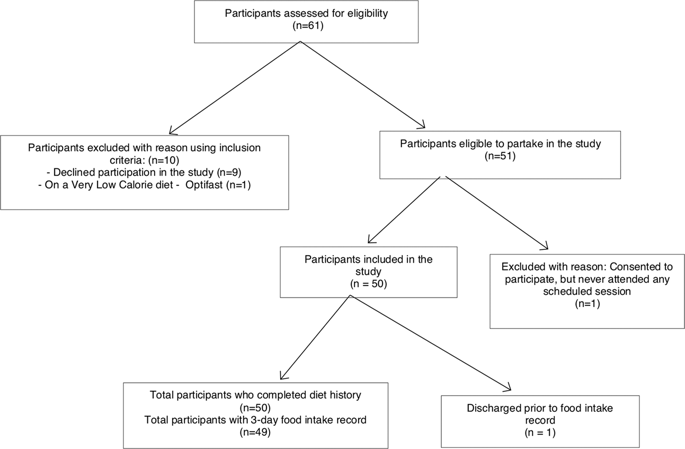当前位置:
X-MOL 学术
›
Spinal Cord
›
论文详情
Our official English website, www.x-mol.net, welcomes your
feedback! (Note: you will need to create a separate account there.)
Exploring nutrition knowledge and dietary intake of adults with spinal cord injury in specialist rehabilitation.
Spinal Cord ( IF 2.1 ) Pub Date : 2020-02-11 , DOI: 10.1038/s41393-020-0430-x Priya Iyer 1 , Eleanor J Beck 2 , Karen L Walton 2
Spinal Cord ( IF 2.1 ) Pub Date : 2020-02-11 , DOI: 10.1038/s41393-020-0430-x Priya Iyer 1 , Eleanor J Beck 2 , Karen L Walton 2
Affiliation

|
STUDY DESIGN
Cross-sectional study.
OBJECTIVES
To explore nutrition knowledge and dietary intake in adults with spinal cord injury (SCI).
SETTING
SCI centre, Australia.
METHODS
A validated General Nutrition Knowledge Questionnaire-R (GNKQ-R) evaluated nutrition knowledge to explore correlations with dietary intake. Dietary intake (current and pre-hospitalisation) was compared with national dietary modelling tools and Nutrient Reference Values (NRV) for assessing nutritional adequacy.
RESULTS
Fifty participants, predominantly male (70%), with a median age of 50 years took part in the study. The mean GNKQ-R score was 59 (13.1)/85 (69%). Participants with a higher level of education scored higher (82%; p < 0.01). The GNKQ-R score was also positively associated with the level of education (r = 0.45; p = < 0.01) with a large effect size (>0.80 Cohen's d). Non-conformance with Australian Dietary Guidelines (ADG) and failure to meet NRV were also noted. Low calcium intakes were found in 69% (n = 34) and saturated fatty acid (SFA) consumption exceeded both the acceptable macronutrient distribution range (AMDR) of 10% for adults (n = 32, 65%) and the lower target of 7% recommended for at-risk groups (n = 49, 100%). Lower nutrition knowledge scores were negatively correlated with SFA intake (r = -0.28; p = 0.05, two-tailed) with a large Cohen's d effect size (>0.80).
CONCLUSIONS
Discordance with the ADG for most food groups was exemplified by high intake of SFA. Individuals with SCI have elevated cardiovascular disease (CVD) risk. Poor nutrition knowledge correlated with high SFA intake, indicates a need for timely, targeted interventions for CVD prevention in this patient group.
中文翻译:

在专科康复中探索成年人脊髓损伤的营养知识和饮食摄入。
研究设计横断面研究。目的探讨成年人脊髓损伤(SCI)的营养知识和饮食摄入。澳大利亚SETTING SCI中心。方法经验证的一般营养知识问卷-R(GNKQ-R)评估了营养知识,以探索与饮食摄入的相关性。将膳食摄入量(当前和住院前)与国家膳食建模工具和营养参考值(NRV)进行比较,以评估营养充足性。结果50名参与者(主要为男性(70%),中位年龄为50岁)参加了该研究。GNKQ-R平均得分为59(13.1)/ 85(69%)。受教育程度较高的参与者得分较高(82%; p <0.01)。GNKQ-R分数也与受教育程度呈正相关(r = 0.45; p = <0.01),且影响大小较大(> 0.80科恩(d)。还注意到不符合澳大利亚饮食指南(ADG)和未达到NRV。发现钙摄入量低(69%)(n = 34),饱和脂肪酸(SFA)的摄入量超过了成年人可接受的常量营养素分布范围(AMDR)10%(n = 32、65%)和较低的目标值7推荐用于高风险人群的百分比(n = 49,100%)。营养知识得分较低与SFA摄入量呈负相关(r = -0.28; p = 0.05,两尾),且Cohen d效应较大(> 0.80)。结论大多数食物组与ADG的不一致以高摄入的SFA为例。SCI患者的心血管疾病(CVD)风险升高。与高SFA摄入量相关的营养知识不足,表明需要及时,
更新日期:2020-02-11
中文翻译:

在专科康复中探索成年人脊髓损伤的营养知识和饮食摄入。
研究设计横断面研究。目的探讨成年人脊髓损伤(SCI)的营养知识和饮食摄入。澳大利亚SETTING SCI中心。方法经验证的一般营养知识问卷-R(GNKQ-R)评估了营养知识,以探索与饮食摄入的相关性。将膳食摄入量(当前和住院前)与国家膳食建模工具和营养参考值(NRV)进行比较,以评估营养充足性。结果50名参与者(主要为男性(70%),中位年龄为50岁)参加了该研究。GNKQ-R平均得分为59(13.1)/ 85(69%)。受教育程度较高的参与者得分较高(82%; p <0.01)。GNKQ-R分数也与受教育程度呈正相关(r = 0.45; p = <0.01),且影响大小较大(> 0.80科恩(d)。还注意到不符合澳大利亚饮食指南(ADG)和未达到NRV。发现钙摄入量低(69%)(n = 34),饱和脂肪酸(SFA)的摄入量超过了成年人可接受的常量营养素分布范围(AMDR)10%(n = 32、65%)和较低的目标值7推荐用于高风险人群的百分比(n = 49,100%)。营养知识得分较低与SFA摄入量呈负相关(r = -0.28; p = 0.05,两尾),且Cohen d效应较大(> 0.80)。结论大多数食物组与ADG的不一致以高摄入的SFA为例。SCI患者的心血管疾病(CVD)风险升高。与高SFA摄入量相关的营养知识不足,表明需要及时,











































 京公网安备 11010802027423号
京公网安备 11010802027423号